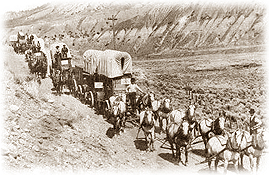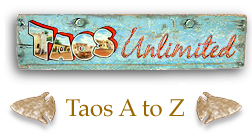|
|||
Wagon  Without wagons, the American West would never have been settled. Wagons, horses, and mules were the only means of transportation for thousands of years. It wasn't by accident that westward expansion and the manufacturing of wagons hit its stride in the 18th century, as these were interdependent. Most wagons were made in the East and shipped westward to the states bordering the frontier, along the Mississippi River. The wagons themselves then took families west along the Santa Fe Trail. Without wagons, the American West would never have been settled. Wagons, horses, and mules were the only means of transportation for thousands of years. It wasn't by accident that westward expansion and the manufacturing of wagons hit its stride in the 18th century, as these were interdependent. Most wagons were made in the East and shipped westward to the states bordering the frontier, along the Mississippi River. The wagons themselves then took families west along the Santa Fe Trail.In the early 19th century, wagon manufacturers starting springing up in the central states, eliminating high shipping costs. Wagon companies ranged from small shops (which produced a wagon a week) to large companies such as Studebaker (which claimed to produce a completed wagon every seven minutes). Hundreds of thousands of wagons were manufactured from the 1700s until 1952, when the last wagon company, the Springfield Wagon Company in Fayetteville, Arkansas, closed its doors forever. Today there are still a few small companies and individuals who continue to make wagons on a much smaller scale. Even through the middle decades of the 20th century, old wagons could occasionally be seen in a pasture or field, each one a symbol of determination and lifeblood that went into the creation of a country. (~Aimee) Wagon Train  A group of covered wagons (prairie schooners) which brought people and supplies to Western America before the building of the railroad. The wagon train replaced pack horse-mule trains as soon as roads had been built. Vast distances through unsettled country, with all its dangers, made it necessary to travel in large parties. Wagon trains were as organized as a military campaign for defense. A contract was drawn up, setting forth the objects carried, the terms of joining, the rules to be followed, and the officers to be elected. All who joined the train signed this paper and then participated in the election of officers. Sometimes a military captain was chosen. There were aides and a guide for the more difficult parts of the route. The order of wagons, both on the trail and in camp, was strictly regulated. At night the wagons were drawn into a circular corral, and a strict guard was kept. Wagon trains disappeared in the East in the 1840s and 1850s, and the Western trails lost importance in the later 19th century. (~Aimee) A group of covered wagons (prairie schooners) which brought people and supplies to Western America before the building of the railroad. The wagon train replaced pack horse-mule trains as soon as roads had been built. Vast distances through unsettled country, with all its dangers, made it necessary to travel in large parties. Wagon trains were as organized as a military campaign for defense. A contract was drawn up, setting forth the objects carried, the terms of joining, the rules to be followed, and the officers to be elected. All who joined the train signed this paper and then participated in the election of officers. Sometimes a military captain was chosen. There were aides and a guide for the more difficult parts of the route. The order of wagons, both on the trail and in camp, was strictly regulated. At night the wagons were drawn into a circular corral, and a strict guard was kept. Wagon trains disappeared in the East in the 1840s and 1850s, and the Western trails lost importance in the later 19th century. (~Aimee)Wild Horse (or Mustang) During the 16th century, Spanish settlers brought their cattle-raising traditions, as well as horses and domestic cattle, with them to the Americas. The arrival of horses was especially significant, as equines had been extinct in the Western hemisphere since the Ice Age. Once here, they quickly multiplied, becoming crucial to the settlers of all nations. As time went on, the original Arabian and Andalusian breeds brought by the Spanish evolved into American horse breeds through selective breeding and natural selection. As descendants of domesticated horses, the Mustang and other horse breeds which are now considered to be "wild horses" could be more accurately termed feral. (~Aimee) Pictured top to bottom: 1} Rustic wagon from the days of the Old West; 2} Wagon Train on the Santa Fe Trail |
|||
Home | Food | Lodging | Merchants | Services | Real Estate | Art & Galleries | Entertainment | Recreation Ski Areas | Mind-Body-Spirit | Taos Information | Local Color | Taos Pueblo | High Road to Taos | Taos Plaza | Ranchos de Taos Scenic Beauty | Day Trips | Chili | Special Events | Taos History | Multicultures | Museums | The Enchanted Circle The Wild West | Taos Art Colony | Plants & Wildlife | Counterculture | Turquoise | Architecture | Features | About Us | Get Listed! Taos Unlimited Trading Post | Photo of the Week | Link of the Month | Taos Webcams | Taos Weather | Testimonials | Guestbook Taos A to Z | Movie Locations | Sitemap | Taos Unlimited Blog | Aimee & Jean's Story Blog | Contact Us | Santa Fe Unlimited |
|||

